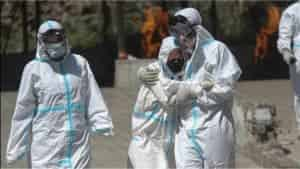WHO predicts that 4.74 million people died in India as a result of Covid-19 is flawed

According to WHO estimations, India’s exact mortality toll from Covid-19 is around ten times the 481,000 deaths reported until December 31, 2021. According to the WHO, there were about 15 million deaths worldwide in 2020 and 2021, roughly triple the reported death toll.
The government said in a statement: “India has been consistently objecting to the methodology adopted by WHO to project excess mortality estimates based on mathematical models. Despite India’s objection to the process, methodology, and outcome of this modeling exercise, WHO has released the excess mortality estimates without adequately addressing India’s concerns.”

During the briefing, Samira Asma, WHO’s assistant director-general for data, analytics, and delivery for impact, emphasized that the WHO works closely with all member states to resolve problems, clarify methods, and request input data. As for those acquainted with the situation in the government, the Indian government has written at least 10 letters to the UN organization in the previous 4-5 months, requesting clarification and vital information about the processes that have been followed, but has received a lukewarm reaction.
India’s objections were based on four main points. First, it rejected modeling as a method – which was designated for tier II countries like India – and stated that only data from the Registrar General of India’s Civil Registration system should be utilized for such estimation.
According to the report, India should not be classed as a tier II country because the country’s mortality data is collected through an effective and strong statutory system. The WHO has yet to reply to India’s complaint, according to the official. India had nearly 470,000 additional fatalities in the first year of the pandemic, according to the CRS data released on May 3.

The government added: “WHO used its own Global Health Estimate 2019 as the base for calculation, which itself is an estimate. Therefore, a modeling approach which provides mortality estimates based on another estimate, while disregarding the actual data available within the Country exhibits a lack of academic rigor.” Furthermore, WHO failed to account for regional variations in test positive and severity, resulting in a “one size fits all” strategy and paradigm, which India rejects. According to experts, India has many systems in place to keep track of the figures.
Dr. Dileep Mavalankar, Director, Indian Institute of Public Health-Gandhinagar, said: “In the time of an epidemic when excess deaths due to all causes are reported with no explanation, it can be attributable to the disease that has caused the outbreak. However, it is an assumption; CRS data is one of the methods, and if you want to validate it then you can compare it with Sample Registration data. Another thing that can help in getting a more thorough census done that will give a more accurate picture.”


